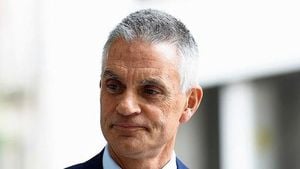On the storied lawns of Wimbledon, tennis history is always in the making. This past week, two remarkable stories—one of a South African giant who once toppled legends and another of a wheelchair tennis prodigy with dreams as big as Centre Court—reminded fans why the sport’s spirit endures across generations and abilities.
Kevin Anderson’s career is a testament to the heights that resilience and raw power can achieve. Born in Johannesburg in 1986, Anderson picked up a racket at age six, balancing tennis with track and field. By 2007, he’d turned pro, and within four years, his thunderous serve and relentless mindset had propelled him into the ATP’s top 50. By 2015, he was entrenched inside the world’s top 10, a fixture on the tour’s biggest stages.
But it wasn’t just the numbers that defined Anderson. His game, built around a serve that rattled even the most seasoned opponents, thrived on hard courts and grass. Tomas Berdych and Stan Wawrinka, two of his fiercest rivals, faced him a combined 21 times—each match a testament to Anderson’s staying power. Yet, as is so often the case in sport, the body sometimes rebels. In 2016, injuries forced Anderson down to No. 74 in the rankings. The following year at Roland Garros, exhaustion forced him to retire mid-match, a gutting moment for a player who’d seemed destined for greater things.
Yet, Anderson’s story was far from over. That difficult stretch became a crucible. Later in 2017, he stormed into his first Grand Slam final at the U.S. Open, falling to Rafael Nadal but proving he belonged among the elite. Then came 2018—a season that would define his legacy. Anderson captured two ATP titles, surged into the top 5, and embarked on an unforgettable run at Wimbledon.
First, he stunned Roger Federer in the quarterfinals, rallying to a 13-11 fifth set victory—his only career win over the Swiss maestro. That match didn’t just mark a personal milestone; it signaled the end of an era. Federer’s 2017 Wimbledon title would stand as his last, as he never again lifted the trophy at the All England Club. For Anderson, the win was monumental, a moment that etched his name into tennis lore.
But the drama wasn’t over. In the semifinals, Anderson faced John Isner in a marathon that stretched 6 hours and 36 minutes, the second-longest match in Wimbledon history. The fifth set alone ended 26-24, a battle of wills that left both men exhausted and the crowd in awe. Though Anderson ultimately fell in the final, his journey captivated fans and underscored the brutal beauty of the sport.
Unfortunately, the physical toll was immense. Multiple knee surgeries and the disruptions of the COVID-19 pandemic eroded Anderson’s consistency. By 2022, at age 35, he decided it was time to step away. His last professional match came in Miami, a loss to Argentina’s Juan Manuel Cerúndolo. In an emotional retirement letter, Anderson wrote, “There were so many people who helped me along the way, and believed that a kid from South Africa could fulfill his dreams.” He finished his career with seven ATP titles and two Grand Slam final appearances, earning respect worldwide for his perseverance and sportsmanship.
Off the court, Anderson’s interests were as varied as his game was powerful. During injury layoffs, he launched a tennis instruction website, eager to share his knowledge. He famously toted his guitar on tour, once strumming during a physiotherapy session—a reminder that even elite athletes crave creative outlets. In 2024, Anderson and his wife made headlines for a different reason: they donated a significant sum to journalist Ben Rothenberg’s legal defense fund. The campaign, organized to cover costs in a defamation lawsuit filed by Alexander Zverev, underscored Anderson’s commitment to supporting integrity and transparency in the sport.
While Anderson’s story is one of reaching the summit and weathering adversity, another tale unfolded on the same Wimbledon grass—one fueled by youthful ambition and the inclusive spirit of modern tennis. Will Barton, a 14-year-old wheelchair tennis prodigy from Gloucester, took part in the national finals of Play Your Way to Wimbledon. The event, powered by Vodafone in partnership with the LTA and the All England Club, is the UK’s largest individual mass participation tennis competition, offering thousands of players a shot at glory on the hallowed Aorangi Courts.
Barton’s journey to SW19 was no small feat. This year’s competition saw thousands compete in qualifying rounds, with county and regional finals in June and July whittling the field down to the nation’s best. The national finals, held from August 3 to August 9, 2025, included categories for juniors, adults, wheelchair athletes, those with learning disabilities, and visually impaired players. Para-standing and deaf tennis exhibition matches added to the week’s celebration of diversity and inclusion.
For Barton, the experience was transformative. “It’s really good to be playing here. It’s my second time here but it’s just as cool because I never really get to play on grass,” he shared. “I watch Wimbledon on TV every year and it’s somewhere I really dream to be in the future so this is inspiring.” Barton, who counts Gordon Reid as his tennis icon, also reflected on his role in the British team’s World Team Cup victory, calling it “really cool and probably my biggest achievement so far.” His ambitions are sky-high: “I really hope to play in the Grand Slams and Paralympics one day.”
The event’s atmosphere was electric, buoyed by the presence of World No.1 wheelchair doubles partners and Vodafone ambassadors Alfie Hewett OBE and Gordon Reid OBE. Both were on hand to cheer on competitors and share their wisdom. “We would have loved to have had something like this when we were younger and playing,” said Hewett. “Play Your Way to Wimbledon is a massive event for someone to pick up a racket for the first time or start playing again if they haven’t for a while. It’s about being active at grassroots level, making friends and new tennis partners and that is the beauty of events like this.” Reid echoed the sentiment: “We want tennis to be available and accessible to everybody and get as many people as possible enjoying the sport. This event encapsulates that perfectly and we’re proud to be a part of it.”
The competition’s scale is impressive: more than 10,000 playing opportunities, 800 venues, and a mission to broaden access to tennis for all ages and abilities. For Barton and his peers, the chance to compete at Wimbledon is more than a dream—it’s a launching pad for future stardom and a testament to the sport’s evolving inclusivity.
As the sun set over Wimbledon’s iconic courts, the echoes of Anderson’s battles and Barton’s aspirations mingled in the summer air. Whether breaking records or breaking barriers, their stories captured the enduring magic of tennis—a sport where every serve, every rally, and every dream matters.




